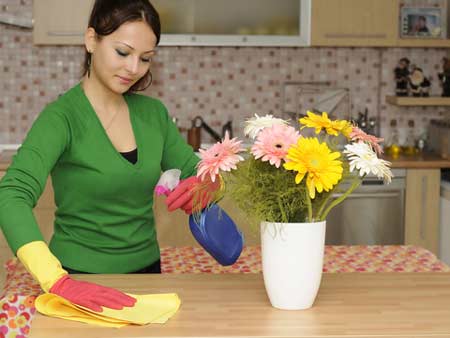Beat Household Dust
Dust can create havoc with our sinus and nasal passages. Don't just spread dust around - get rid of it! Here are some dust-busting strategies.
The solution to most household problems is to attack the source. But you can’t eliminate the sources of household dust. You can’t even do much to reduce them, because more than 90 percent of household dust comes from people and fabric. Our bodies constantly shed tiny flakes of skin. Our clothes, bedding and furnishings constantly shed barely visible fibres. These flakes and fibres float on the slightest air currents and settle on every surface in your house. In a spot sheltered from air movement, the particles stay put. In other areas, they constantly rise and settle as doors swing open and people pass by.
Keep closet floors clear for easy cleaning
Closets are dust reservoirs, full of tiny fibres from clothes, towels and bedding. Every time you open the door, you whip up an invisible dust storm. You can’t prevent clothes from shedding fibres, but you can make closets easier to keep clean and vastly cut down on dust.
Box or bag items on shelves. Clear plastic containers are best - they lock fibres in and dust out and let you see what’s inside. When you dust, they’re easy to pull off the shelves and wipe clean.
Enclose the clothes you rarely wear, they shed fibres year-round. Slip garment bags or large garbage bags over them. They help to contain fibres and keep the clothes themselves from becoming coated with dust.
Keep closet floors clear. If the floor is cluttered, chances are you’ll just bypass it while vacuuming. But a wide-open floor adds only a few seconds to the vacuuming chore. And a wire shelf lets you clear all those shoes off the floor without losing storage space.
Good night - Don't let the bed bugs bite!
Your cosy bed is a major dust distributor. The bedding collects skin flakes, sheds its own fibres and sends out a puff of dust every time you roll over. To minimise the fallout, wash sheets and pillowcases weekly. Items that aren’t machine washable don’t need weekly trips to the dry cleaners - just take blankets and bedspreads outside and shake them. You can spank some of the dust out of pillows, but for a thorough cleaning, wash or dry-clean them. When you change bedding, don’t whip up a dust storm. Gently roll up the old sheets and spread out the new ones; even clean bedding sheds fibres.
Capture dust - don’t just spread it around
Feather dusters and dry rags pick up some of the dust they disturb, but most of it just settles elsewhere. Damp rags or disposable cloths that attract and hold dust with an electrostatic charge work much better. Cloths that attract dust with oils or waxes also work well but can leave residue on furniture. Use vacuum attachments only on surfaces that are hard to dust with a cloth, such as rough surfaces and intricate woodwork, because the exhaust stream from a vacuum whips up a dust storm.
Beat and shake area rugs
In most homes, carpet is by far the biggest dust reservoir. Even the padding underneath holds dust, which goes airborne with each footstep. Some serious allergy sufferers find that the only solution is to tear out wall-to-wall carpet and install hard flooring like wood or tile. Those of us who don’t want to take that drastic step have to vacuum regularly. Vacuum pathways and busy areas at least once a week. The dust that gathers under chairs or behind the sofa is less important. It stays put unless it’s disturbed by a toddler, a pet or a breeze. Vacuum large area rugs too. But also take them outside three or four times a year for a more thorough cleaning. Drape them over a fence or clothesline and beat them with a broom or tennis racket. A good beating removes much more dust than vacuuming. Take smaller rugs outside for a vigorous shaking every week.
Take cushions out for a beating
Upholstery fabric not only sheds its own fibres but also absorbs dust that settles on it. You raise puffs of dust every time you sit down. There are three ways to reduce dust on fabric:
Dust settles mostly on horizontal surfaces; vacuum them weekly. Vacuum vertical surfaces monthly.
Take cushions outside and beat the dust out of them. An old tennis racket works well and lets you practice your backhand. A thorough beating removes deeply embedded dust better than vacuuming.
Slipcovers for chairs and sofas are easy to pull off and take outdoors for a shaking. Better yet, some are machine washable. Slipcovers are readily available at discount and home furnishings stores.
Match the vacuum to the flooring
Suction alone isn’t enough to pull much dust out of carpet. For good results, you need a vacuum with a powerful agitator. Upright vacuums are usually best for carpet, although some canister vacuums with agitators work well, too.

